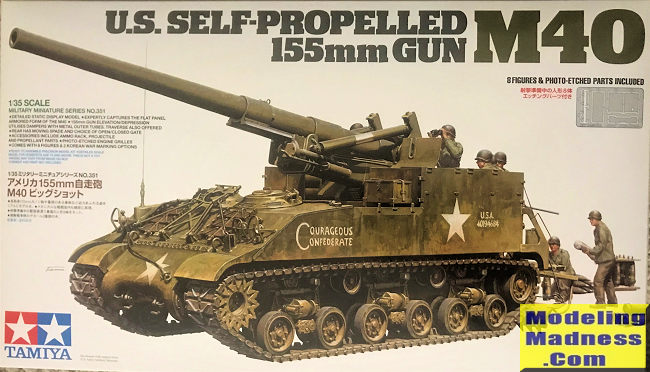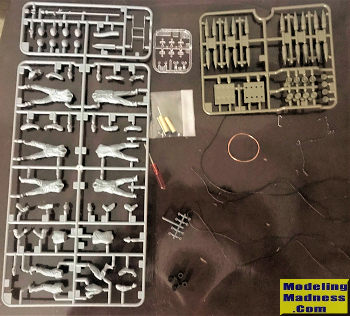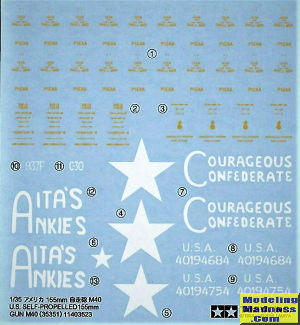
Tamiya 1/35 M40 “Big Shot”
| KIT #: | MM-351 |
| PRICE: | $60.005 |
| DECALS: | Two options |
| REVIEWER: | Donald Zhou |
| NOTES: |
Advantages:
Extremely detailed, entire gun crew included, nice fit. Disadvantages: details somewhat simplified, cash grab of metal barrel, marking limiteds |

| HISTORY |
The history of U.S. Army self-propelled artillery was a long and arduous one. This was due to no small uncertain facts that well…Let’s just say that the Army sometimes are very conservative, even to its own detriment. Just look at what happened to the M4 Sherman when a replacement, the T26 was ready…and was nearly completely got stomped by men like Leslie McNair, who held on to the dear of all dear mantra of “Tanks are for tank destroyers. Tanks are only for infantry support” even when all the evidence and reality were flying in the face of that now obsolescence mantra!
But one good thing though, was Leslie was a good artillery officer and he would happily approve anything that can go long distance and make a big “BOOM”! Despite initially massive resistance on self-propelled artillery, thinking that towed pieces will be the norm, Leslie and others gave approval for vehicles like the M7 to see combat in 1942, most often with the British and looked on with interests. When the “Priest” became a huge success and extremely popular to the point where the British can’t get enough of them, even though the 105mm shells it fires proved to be a logistical nightmare (since the British normally don’t use that diameter type of shells. Hence why they modified some of the Priests to fire their own 25 pounder shells and renamed it the Sexton). A bigger piece was quickly developed afterwards, the M12 155mm self-propelled gun. This used a M3 Grant chassis and mounted a copy of the French Cannon de 155mm GPF. The vehicle was open top. With the Commander and Driver operating the vehicle in closed cupulas at the front. The engine and associated equipment is at the center of the vehicle, leaving the rear open to be operated in firing mode. A large spade was added to the rear and deployed to be inserted into the ground to help against recoil. This pattern, an open rear compartment, a large spade etc was to become the pattern for many future self-propelled artillery pieces.
The cannon was employed after the Normandy landings and enjoyed great success. Although designed in the indirect fire role, sometimes the vehicle was employed in the direct fire role with devastating effect! During the assault on the Siegfried Line, the cannon earned the nickname “Doorknocker” for its penchant at knocking out concrete pillboxes and fortifications. At a range of 2000 yards/meters, well away from enemy counter fire except artillery, a single armor-piercing shell can easily shatter 7ft of concrete. An infantry man who saw the aftermath of such a strike remembered although the concrete pillbox may not have been completely blown up, the occupants were either dead, blown to bits or if they survived, too shell shocked to do anything! Later on, in the Battle of Aachen, once again, the M12 was called upon to knock loose some doors. When the fighting reached a fever pitch and the Germans just won’t come out of houses and the streets, the Americans rolled out the M12. Just like the Russians later on in Berlin, who used their 203mm B4 to great effect, the Americans started to fire 155mm high-explosive shells into any buildings containing German resistance. The German quickly found out the M12 could stay well away from snipers and Panzerfaust and just one 155mm high-explosive round could level half a city block! Afterwards, the mere sight of the vehicle would cause them to surrender or flee in terror. After surrendering the city, the German commander dryly commented that whoever came up with the idea of using the M12 in city streets should be carried out back and shot for “crimes against humanity!” The vehicle earned a new nickname “King Kong” due to its awesome firepower. Such successes quickly spurred the American to develop a replacement.
The idea for the M40 came about as early as late 1943. 5 prototypes were commission in early March 1944. The vehicle, then known as the Gun Motor Carriage T83, was built on an improved M4 chassis that was widened and lengthened and used the HVSS suspension system. Like the M12, the piece had the commander and driver in front of the vehicle when driving it. The engine and associated equipment were located in the center, leaving the rear open for operating the artillery piece, in this case, the improved M1 155mm “Long Tom” cannon. A total of eight crew members were needed to operate the big gun. The vehicle was tested at Aberdeen Proving Ground throughout 1944 and production began in February 1945. In May 1945, it was standardized as the 155mm Gun Motor Carriage M40 and nicknamed the “Big Shot” by crews.
By the time the new piece entered service in May 1945, the war in Europe was all about over. A single prototype piece, the third prototype T83, was sent to Europe for combat testing, were it acquitted well for itself. Supposedly, it was this vehicle that fired the first shot to open the Siege of Cologne. Some 400 vehicles were produced in preparation for the Invasion of Japan but of course, that never came when the two Big Bombs were dropped on Hiroshima and Nagasaki. The cannon’s baptism of fire came during the Korean War, where it, along with other equipment were hurriedly thrown into the fray after the North invaded. It served with both the 937th and 204th field artillery battalions throughout the war with distinction, fighting from 1951 all the way through the armistice signing in 1953.
The piece was also given to the British to fill their interim need, where it was christened the “Cardinal” alongside the British tradition of naming self-propelled artillery pieces with angelic names.
| THE KIT |
 Ok,
so many moons ago, AFV Club released the first M40 kit in 1/35 scale based on
their excellent M1 “Long Tom” cannon. It was great in detail, and very welcomed.
However, there was one serious complaint. It was that the track was only used on
the T83, not on operational vehicles. However, since aftermarket Sherman tracks
are all over the place, it was a minor quibble and for years, it was the only
game in town if you want a nice, well detailed M40 “Big Shot” kit.
Ok,
so many moons ago, AFV Club released the first M40 kit in 1/35 scale based on
their excellent M1 “Long Tom” cannon. It was great in detail, and very welcomed.
However, there was one serious complaint. It was that the track was only used on
the T83, not on operational vehicles. However, since aftermarket Sherman tracks
are all over the place, it was a minor quibble and for years, it was the only
game in town if you want a nice, well detailed M40 “Big Shot” kit.
Warp so many years later. 2 years ago, Tamiya announced and then released their own M40, developed with the assistance of the U.S. Artillery Museum. So, what’s so different about this than the AFV Club version? Well, I don’t have the AFV Club version so can’t tell. But judging from pics from the web, the differences are many. The least of which, the suspension is a lot simpler. The Tamiya version just uses their own M4A3E8 kit HVSS suspensions, which contain all of eight parts and a snap to assemble. AFV Club has a one piece hull. Tamiya is separated for ease of assembly and simpler to deal with. Most of all, Tamiya offers the correct metal chevron type tracks found on operational vehicles. Again, AFV tracks are only used on prototypes. However, there are some minor faults with the Tamiya kit. The metal barrel is a cash grab and is separate purchase. Although not expensive at $18-$22 and offers a bevy of brass shells also. Still, I feel it should’ve included in the kit as the kit’s plastic barrel is in halves and no interior detail (The metal barrel has rifling). For serious modeler, it’s basically a must have purchase. The second is the markings. Nothing wrong but only 2?!?!?!? Even the AFV Club offers seven markings, including the pilot vehicle served in WWII, a British “Cardinal” version and both the Tamiya’s version, The “Courageous Confederate” and “Aita's Ankies” are included in the AFV Club’s markings! Come on Tamiya! Give us some options here!
S till,
this kit offers something no other kit could offer. It’s a little more part
intensive than Tamiya's other armor kits with a part count of almost 500.
However, it does contain all eight gun crew that served on a real M40 including
the commander/sighter, Gun Crew Chief, a fuse setter, a propellant charge holder
and four loaders including two holding a tray with a 155mm shell on it, ready to
load into the breech and two holding a rammer, ready to ram the round home.
Notice these four figures, some have the tray handle and the rammer molded on
their hands. Other than that, extra shells, separate and in their holders,
propellants in their cases are included so you can easily create your own fire
base diorama. Other than that, a bunch of nylon ropes, screws and metal chains
are also included.
till,
this kit offers something no other kit could offer. It’s a little more part
intensive than Tamiya's other armor kits with a part count of almost 500.
However, it does contain all eight gun crew that served on a real M40 including
the commander/sighter, Gun Crew Chief, a fuse setter, a propellant charge holder
and four loaders including two holding a tray with a 155mm shell on it, ready to
load into the breech and two holding a rammer, ready to ram the round home.
Notice these four figures, some have the tray handle and the rammer molded on
their hands. Other than that, extra shells, separate and in their holders,
propellants in their cases are included so you can easily create your own fire
base diorama. Other than that, a bunch of nylon ropes, screws and metal chains
are also included.
Following the steps in the instructions, one begins with the hull naturally. As expected, the kit is separated into two pieces, the hull and the cannon itself. The basic hull assembly are big and easy so take your time. Like any Tamiya kit, it should simply fall together.
Then come the differential cover and the HVSS bogies. This should be very familiar for anyone who assembled any of the Tamiya’s M4A3E8 Shermans. Tracks are plastic. Again, may not sit pretty with someone but a joy for a guy like me who hate pesky multipart individual track assemblies.
Next are all the upper hull part details. Some parts again, are from Tamiya own Sherman lines but most are new. A lot of the pioneer tools etc may be needed to be left off until major painting are done. A movable and detailed gun travel lock is assembled here.
Next major assembly deals with the fighting compartment. Here, the storage containers, ammo racks and rear side walls are assembled. Notice you need to take the thick nylon twine and make a winch that will later on attached to the dozer blade. Some photo etch will be used here for the rear floor so break out the superglue.
The massive dozer blade is assembled next. Remember
you can only display it in the “down” position if you choose to keep the rear
ramp open even if it is designed to be movable. Next part be ultra-careful and
study the instruction as you need to draw out the winch line and attach the rope
to the dozer blade. As expected, the down blade will require more line drawn
out. Make sure the line is taught and tight. Might be a good idea after
tightening the rope, zap it shut with superglue. The rear ramp will be made
next. Again, there are two versions. One in the down position and one up. Two
metal chains will also be
 needed to
attach to the down ramp so take your time. The vehicle is completes at this
point so onto the gun itself.
needed to
attach to the down ramp so take your time. The vehicle is completes at this
point so onto the gun itself.
The gun assembly begin with the breech. Notice you are now messing around with screws and nuts. A lot of subassemblies so take your time. Poly caps are also used to ensure the gun can move afterwards. The trunnions are finished and then it’s on to the equilibrators. Again, screws are now used to ensure a tight, movable joint. Sighting units and the gun shields are now attached to the main trunnions.
Finally, the gun tube itself is made and attached. Again, serious modelers need to get the metal replacement. The gun breech is also assembled and attached. The finished gun is then attached to the fighting compartment, along with the tow ropes, which also use nylon twines. The final page shows the assembly of the eight crew figures and the placement of them when operating the gun. This is optional but it does add some personality to the model.
| CONCLUSIONS |
Again, this is another great kit from Tamiya and it is at the forefront of the fourth generation of Tamiya kits. It still offers Tamiya’s famed ease of assembly but contains enough details that it will turn out into a show stopper in the right hand, especially with the aftermarket metal barrel….Cash grab not withstanding! You can forgo the figures and just make the vehicle. Or make the figures and turn the piece into quite the diorama by just adding the base and the setting. All in all, this is a bargain at just $60 if you import directly from Japan!
If you would like your product reviewed fairly and fairly quickly, please contact the editor or see other details in the Note to Contributors.
Back to the Main Page Back to the Review Index Page Back to the Previews Index Page